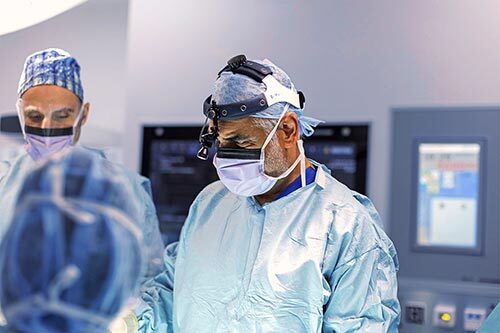Keyhole ASD Closure
Read MoreASSOCIATED CONDITIONS
What is Atrial Septal Defect (ASD)?
Atrial septal defect (ASD) is a congenital heart defect whereby a hole is present between the two collecting chambers of the heart, and results in blood overloading the right side of the heart. If a large defect is untreated, ASD can lead to further issues with the heart and the lungs, so it’s important to undergo an ASD procedure as early as possible if necessary. However, in many cases, ASD may have no symptoms and may not require treatment.
As with many heart issues, atrial septal defects are congenital, meaning they are present at birth. ASD occurs when the heart does not develop normally in the womb, but the cause of this is not known. At birth it is normal to have openings in the upper heart chambers. However, these usually close within a few weeks or months after birth. An opening that does not close becomes an atrial septal defect.
What Atrial Septal Defect Treatment is Available?
The atrial septal defect treatment depends on the size of the hole in the dividing wall of the left and right atrium. Small children who have ASD may not need treatment if the atrial septal defect is not causing any symptoms. However, if the defect is causing the heart to stretch and enlarge, surgery is usually recommended to close the hole. If the hole is large, common symptoms include heart palpitations, shortness of breath and stroke. When left untreated, ASD may lead to irregular heartbeats, heart failure and lung damage. It is therefore important to seek appropriate atrial septal defect treatment in order to prevent long-term effects.
There are two types of treatment available for ASD: the Amplatzer Device closure method, and keyhole heart surgery. The best treatment for ASD differs from person to person, and procedure that is chosen will depend on the size, location and severity of the defect. At our London Heart Clinic, we offer consultations for atrial septal defects can help determine the best solution for you.
ASD Amplatzer Device Closure Method
This procedure is suitable for some patients with ASD. It involves the insertion of a long thin tube (catheter) into the groin, through to the heart. The catheter carries a collapsed closure device into the heart, which, when deployed, opens like an umbrella to close the defect. The amplatzer device used in the closure remain permanently implanted, with tissue growing over it, so the device becomes part of the muscle wall. Patients tend to only need to be hospitalized for one day when having this an Amplatzer Device closure procedure, with minimal recovery time. However, Amplatzer Device closure using a catheter is not always possible if the hole on the heart’s chamber is abnormally large or difficult to locate. The video below demonstrates the process of an Amplatzer Device closure.
Keyhole ASD Closure Surgery
If the defect is large or located in an abnormal position, then atrial septal defect surgery may be needed. Keyhole ASD closure can be performed between the ribs on the right side of the chest. This allows excellent repair of the defect, by either direct closure, or using a patch which is carefully sewn into place. The cuts used will heal up in a few days leading to a swifter recovery than the traditional breastbone approach to ASD closure.
At our London heart clinic, as well as in other locations, we offer keyhole ASD closure if it is suitable for you. There are many benefits of using keyhole atrial septal defect surgery instead of traditional open-heart surgery, including that you will not need to have your breastbone divided, helping you heal within a few days rather than months. You will have no risk of bone infection and be able to resume your daily activates within a few days after your ASD closure. This is an alternative to traditional open heart surgery, where the breastbone would be broken and take months to heal.
There is also much greater cosmetic appeal to using a keyhole ASD closure, you will be left with a much smaller scar than scars caused by traditional heart surgery. The keyhole atrial septal defect surgery also causes minimal pain and discomfort as there is no breastbone break. The healing process will be much more comfortable and milder in comparison to traditional surgery.
Speak to Our Team Today About the ASD Procedure
A keyhole atrial septal defect surgery could be the ideal solution for those with ASD. Not everyone with ASD will need to undergo surgery, as very small atrial septal defects can even close spontaneously after a few years and not cause any complications or require treatment. However, atrial septal defects can cause problems with the heart when extra blood overfills the lungs and right side of the heart. At The Keyhole Essex Heart Clinic, we can offer a less painful and quicker recovery solution to open heart surgery that can be suitable for those with an atrial septal defect that is large or in an obscure position.
Please get in touch with us today to arrange a consultation or a remote appointment with our team, and we can discuss the right path for your ASD treatment. To learn more about what we do at the Keyhole Heart Clinic and our team, view our video section full of further insight.
Services
How We Can Help You









